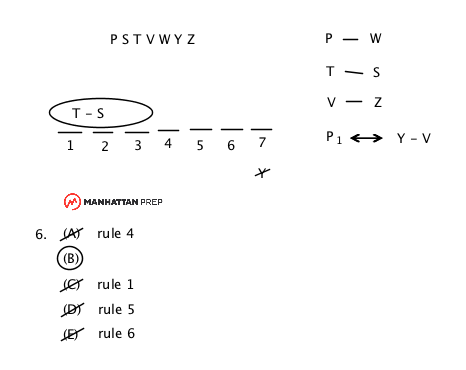LSAT Forum
5 postsPage 1 of 1
-

- jennifertrimo
-
Thanks Received: 0
-
Vinny Gambini

- Posts: 7
- Joined: October 26th, 2014
Q6
Can someone explain why E is wrong please?
-

- ManhattanPrepLSAT1
-
Thanks Received: 1909
-
Atticus Finch

- Posts: 2851
- Joined: October 07th, 2009
Re: Q6
jennifertrimo Wrote:Can someone explain why E is wrong please?
Rule 6 can be notated in the following way:
P(1) <--> Y - V
So what's the contrapositive?
~P(1) <--> V - Y
Answer choice (E) breaks the contrapositive of rule 6.
-

- ManhattanPrepLSAT1
-
Thanks Received: 1909
-
Atticus Finch

- Posts: 2851
- Joined: October 07th, 2009
-

- andrewgong01
-
Thanks Received: 61
-
Atticus Finch

- Posts: 289
- Joined: October 31st, 2016
- This post thanked 1 time.
Re: Q6
sofiemv26 Wrote:Can someone please explain why P1 <----> Y - V. I had it as P1 ----> Y - V. Are all "if, but only if" questions double arrows?
Thanks!
If and only if is a biconditional relation and biconditional relations allow for the two way reversal of the arrorow where it goes both ways. Generally, I just use the fact and draw it with two directions on the arrows without thinking much but the fuller intution is that you can break apart the phrase of if and only if.
Original: P1 if and only if [but only if] Y is before V. The "and"/"but" really is just a conjunction that fused two phrases together. You can break it apart as : P1 if Y is before V AND P1 only if Y is before V. As you can see, in one instance P1 is a necessary condition and in the other case it is the sufficient condition. Constructing the double arrow:
P1 if Y is before V becomes Y - V -->P1 [1] P1 only if Y is before V becomes P1 -->Y-V [2]
Notice that in one instance the arrow points to P1 and the other instance it points to Y-V.
Combined in a single diagram, as a shorthand, you get two arrows. Sometimes bi-conditionals are useful for framing because they are triggered (almost always depending on the game) and may lead to some inferences or at the very least limited ways the can play out.
5 posts Page 1 of 1
